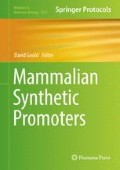Abstract
It has been pointed out that ultrasound could be used as a controller for bioprocesses including gene expression since its energy can noninvasively reach deep in the body. Gene expression may be timely and spatially controlled by ultrasound, thus providing necessary bioactive proteins for the targeted tissue in a timely fashion. Although there are many processes involved in gene expression control, one of the most important processes is transcription, and the promoter plays an essential role in it. There are several promoters known to be activated in response to ultrasound irradiation. However, in our opinion, an artificial promoter is more suitable for clinical use. We herein describe simple methods to construct promoters that are responsive to ultrasound irradiation by randomly combining cis-elements (transcription factor binding motifs) and thereby improve its reactivity to ultrasound irradiation.
References
Ashush H, Rozenszajn LA, Blass M, Barda-Saad M, Azimov D, Radnay J, Zipori D, Rosenschein U (2000) Apoptosis induction of human myeloid leukemic cells by ultrasound exposure. Cancer Res 60:1014–1020
Tabuchi Y, Kondo T, Ogawa R, Mori H (2002) DNA microarray analyses of genes elicited by ultrasound in human U937 cells. Biochem Biophys Res Commun 290:498–503
Abdollahi A, Domhan S, Jenne JW, Hallaj M, Dell'Aqua G, Mueckenthaler M, Richter A, Martin H, Debus J, Ansorge W, Hynynen K, Huber PE (2004) Apoptosis signals in lymphoblasts induced by focused ultrasound. FASEB J 18:1413–1414
Ogawa R, Watanabe A, Morii A (2015) Ultrasound up-regulates expression of heme oxygenase-1 gene in endothelial cells. J Med Ultrason 42:467–475
Kagiya G, Ogawa R, Tabuchi Y, Feril LB Jr, Nozaki T, Fukuda S, Yamamoto K, Kondo T (2006) Expression of heme oxygenase-1 due to intracellular reactive oxygen species induced by ultrasound. Ultrason Sonochem 13:388–396
Kagiya G, Tabuchi Y, Feril LB Jr, Ogawa R, Zhao QL, Kudo N, Hiraoka W, Tachibana K, Umemura S, Kondo T (2006) Confirmation of enhanced expression of heme oxygenase-1 gene induced by ultrasound and its mechanism: analysis by cDNA microarray system, real-time quantitative PCR, and western blotting. J Med Ultrason 33:3–10
Kagiya G, Ogawa R, Hatashita M, Takagi K, Kodaki T, Hiroishi S, Yamamoto K (2005) Generation of a strong promoter for Escherichia coli from eukaryotic genome DNA. J Biotechnol 115:239–248
Ueda T, Akiyama N, Sai H, Oya N, Noda M, Hiraoka M, Kizaka-Kondoh S (2001) C-iap2 is induced by ionizing radiation through nf-kappab binding sites. FEBS Lett 491:40–44
Hu Z, Jin S, Scotto KW (2000) Transcriptional activation of the mdr1 gene by uv irradiation. Role of nf-y and sp1. J Biol Chem 275:2979–2985
Hallahan DE, Dunphy E, Kuchibhotla J, Kraft A, Unlap T, Weichselbaum RR (1996) Prolonged c-jun expression in irradiated ataxia telangiectasia fibroblasts. Int J Radiat Oncol Biol Phys 36:355–360
Datta R, Rubin E, Sukhatme V, Qureshi S, Hallahan D, Weichselbaum RR, Kufe DW (1992) Ionizing radiation activates transcription of the egr1 gene via carg elements. Proc Natl Acad Sci U S A 89:10149–10153
Watanabe A, Kakutani S, Ogawa R, Lee SI, Yoshida T, Morii A, Kagiya G, Feril LB Jr, Fuse H, Kondo T (2009) Construction of artificial promoters sensitively responsive to sonication. J Med Ultrason 36:9–17
Furusawa Y, Hassan MA, Zhao QL, Ogawa R, Tabuchi Y, Kondo T (2014) Effects of therapeutic ultrasound on the nucleus and genomic DNA. Ultrason Sonochem 21:2061–2068
Feril LB Jr, Kondo T, Ogawa R, Zhao QL (2003) Dose-dependent inhibition of ultrasound-induced cell killing and free radical production by carbon dioxide. Ultrason Sonochem 10:81–84
Acknowledgement
This study was supported in part by Grants-in-Aid for Scientific Research (C) (21500403) and (18500374) and for Young Scientist (B) (20377253) and (23791746) from Japan Society for the Promotion of Science, the Research and Development Committee Program of the Japan Society of Ultrasonics in Medicine, a New Manufacture and Venture Creation Grant (Biotechnology) of Toyama New Industry Organization, a research grant of the First Bank of Toyama Foundation, and by Collaborative Research Project of the Wakasa Wan Energy Research Center.
Author information
Authors and Affiliations
Corresponding author
Editor information
Editors and Affiliations
Rights and permissions
Copyright information
© 2017 Springer Science+Business Media LLC
About this protocol
Cite this protocol
Ogawa, R., Kagiya, G., Watanabe, A., Morii, A., Cui, ZG., Kondo, T. (2017). A Simple Method for Constructing Artificial Promoters Activated in Response to Ultrasound Stimulation. In: Gould, D. (eds) Mammalian Synthetic Promoters. Methods in Molecular Biology, vol 1651. Humana, New York, NY. https://doi.org/10.1007/978-1-4939-7223-4_14
Download citation
DOI: https://doi.org/10.1007/978-1-4939-7223-4_14
Published:
Publisher Name: Humana, New York, NY
Print ISBN: 978-1-4939-7221-0
Online ISBN: 978-1-4939-7223-4
eBook Packages: Springer Protocols

